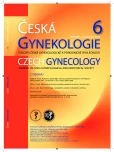-
Medical journals
- Career
Monochorionic biamniotic twins with a common yolk sac in the first trimester ultrasound scan – is there a higher risk of a congenital defect?
Authors: M. Poláková 1; L. Zetová 1; R. Vlk 2; Š. Vejvalková 3
Authors‘ workplace: GEST IVF, Centrum reprodukční medicíny, Praha, vedoucí MUDr. J. Šulc a MUDr. M. Čekal 1; Gynekologicko-porodnická klinika 2. LF UK a FN Motol, Praha, přednosta prof. MUDr. L. Rob, CSc. 2; Ústav lékařské biologie a genetiky 2. LF UK a FN Motol, Praha, přednosta prof. MUDr. M. Macek, DrSc. 3
Published in: Ceska Gynekol 2012; 77(6): 521-523
Overview
Type of study:
Case report.Setting:
GEST IVF, Centre of Reproductive Medicine, Prague.Methods:
The case report describes pregnancy after IVF + ET. The first trimester ultrasound scan showed monochorionic biamniotic twins with one common yolk sac (YS) only, which is possible in biamniotic twins, but very rare. Identical congenital defects such as anal, coccygeal atresia, and others, were diagnosed prenatally and postnatally in both twins.Conclusion:
Yolk sac number in monochorionic twins can play an importart role in embryogenesi. Any possible relation with certain congenital defects has not yet been described. It is necessary to describe more cases.Key words:
multiple pregnancy, monochorionic twins, yolk sac number.
Sources
1. Alen, VM., et al. Management of monoamniotic twin pregnancies: a case series and systematic review of the literature. BJOG, 2001, 108, 9, p. 931–936.
2. Bishop, DK. Yolk-sac number in monoamniotic twins. Obstet Gynecol, 2010, 116, Suppl. 2.
3. Bromley, B. Using the number of yolk sacs to determine amnionicity in early first trimester monochorionic twins. J Ultrasound Med, 1995, 14, 6, p. 415–419.
4. Demaria, F., Goffinet, F., Kayem, G., et al. Monoamniotic twin pregnancies: antenatal management and perinatal results od 19 consecutive cases. BJOG, 2004, 111, 1, p. 22–26.
5. Hulvert, J., Mardešič, T., Muller, P., et al. Monochoriální dvojčata po léčbě sterility metodami asistované reprodukce. Čes Gynek, 1999, 64, 5, p. 295–299.
6. Charles, A., et al. Diamniotic conjoined fetuses in a triplet pregnancy: an insight into embryonic topology. Pediatr Dev Pathol, 2005, 8, 6, p. 666–672.
7. Levi, CS., et al. Yolk sac number, size and morfologic features in monochorionic momoamniotic twin pregnancy. Can Assoc Radiol J, 1996, 47, 2, p. 98–100.
8. Malinowski, W. Yolk sacs in twin pregnancy. Ginekol Pol, 2000, 71, 8, p. 815–818.
9. Malinowski, W. Umbilical cord complications in twin pregnanties. Ginekol Pol, 2003, 74, 10, p. 1208–1212.
10. Moore, KL., Persaud, TVN. Zrození člověka – Embryologie s klinickým zaměřením. Praha: ISV, 2002.
11. Murakoshi, T., et al. Monochorionic monoamniotic twin pregnancies with two yolk sacs may not be a rare finding: a report of two cases. Ultrasound Obstet Gynecol, 2010, 36, 3, 384–386.
12. Shen, O., et al. Number of yolk sacs does not predict amnionicity in early first-trimester monochorionic multiple gestations. Ultrasond Obstet Gynecol, 2006, 27, p. 53–55.
Labels
Paediatric gynaecology Gynaecology and obstetrics Reproduction medicine
Article was published inCzech Gynaecology

2012 Issue 6-
All articles in this issue
- Follow-up after the treatment of ovarian cancer – really without Ca 125?
- Comparison of selective oxidative stress parameters in the follicular fluidof infertile women and healthy fertile oocyte donors
- Conservative method in treatment of placenta accreta – two case reports
- The safety of home birth and evidence-based medicine
- Homebirth in Czech Republic
- The structural basis for transport through the Fallopian tube
- Developmental impairment of children with very low and extremely low birth weight at 24 months corrected age, born in the Czech Republic in 2000–2009
- High birthweight births at University Hospital Olomouc (1993–2010)
- Endovascular treatment of obstetric hemorrhage
- Role of leptin in human reproduction (anorexia, bulimia)
- Dehiscence of laparotomy after hysterectomy – wound management
- Incidence of infection of newborns of GBS positive mothers in relationto peripartal antibiotic prophylaxis or mode of delivery
- Accuracy of placenta accreta ultrasound prediction in clinical work
- The new technologies for the analytical examination of the embryonic metabolome and its prospects
- 3D MRI-based brachytherapy in patients with locally advanced cervical carcinoma – early clinical results
- Modern surgical and biological therapy of breast cancer
- Monochorionic biamniotic twins with a common yolk sac in the first trimester ultrasound scan – is there a higher risk of a congenital defect?
- Self-rated health status and its implications.Population study of pregnant women in Brno
-
Rapidly doubling endometrioma
An endometrioma can double its size within 2 weeksunder special conditions
- Czech Gynaecology
- Journal archive
- Current issue
- Online only
- About the journal
Most read in this issue- Monochorionic biamniotic twins with a common yolk sac in the first trimester ultrasound scan – is there a higher risk of a congenital defect?
- Homebirth in Czech Republic
- Conservative method in treatment of placenta accreta – two case reports
- Dehiscence of laparotomy after hysterectomy – wound management
Login#ADS_BOTTOM_SCRIPTS#Forgotten passwordEnter the email address that you registered with. We will send you instructions on how to set a new password.
- Career

